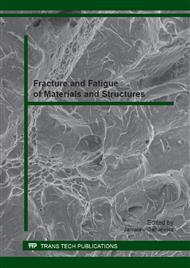[1]
D. Radaj, Review of fatigue strength assessment of nonwelded and welded structures based on local parameters. International Journal of Fatigue 18, (1996) 153-170.
DOI: 10.1016/0142-1123(95)00117-4
Google Scholar
[2]
E. Niemi, Aspects of good design practice for fatigue-loaded welded components, Proceedings of the International Symposium on Fatigue, ESIS Publication 16, Mechanical Engineering Publications, (1993) 233-351.
Google Scholar
[3]
C.M. Sonsino, D. Radaj, U. Brandt, H.P. Lehrke, Fatigue assesment of welded joints in AlMg4.5Mn aluminium alloy (AA 5083) by local approaches, International Journal of Fatigue 21, (1999) 985-999.
DOI: 10.1016/s0142-1123(99)00049-3
Google Scholar
[4]
S.J. Maddox, Rewiev of fatigue assessment procedures for welded aluminium structures, International Journal of Fatigue 25, (2003) 1359-1378.
DOI: 10.1016/s0142-1123(03)00063-x
Google Scholar
[5]
F.V. Lawrence, R.J. Mattos, Y. Higashida, J.D. Burk, Estimation of fatigue initiation life of welds, ASTM STP 648, 134-158, 1978.
DOI: 10.1520/stp33393s
Google Scholar
[6]
R.J. Mattos, F.V. Lawrence, Estimation of the fatigue crack initiation life in welds using low-cycle fatigue concepts. SAE SP-424, Society of Automative Engineering, Warrendale, 1977.
Google Scholar
[7]
A. Tricoteaux, S. Degallais, F. Sauvage, Calculations of the fatigue crack initiation life in HSS Steel welded joints by a local stress-strain approach method, Proceedings of Fatigue Design 95, Helsinki, (1995) 111-124.
DOI: 10.1111/j.1460-2695.1995.tb00154.x
Google Scholar
[8]
X. Niu, G. Glinka, The weld profile effect on stress intensity factor in weldments. International Journal of Fracture 35, (1987) 3-20.
DOI: 10.1007/bf00034531
Google Scholar
[9]
R. Tovo, P. Lazzarin, Relationships between local and structural stress in the evaluation of the weld toe stress distribution, International Journal of Fatigue 21, (1999) 1063-1078.
DOI: 10.1016/s0142-1123(99)00089-4
Google Scholar
[10]
D. Radaj, C.M. Sonsino, D. Flade, Prediction of service fatigue strength of a welded tubular joint on the basis of the notch strain approach, International Journal of Fatigue 20, (1998) 471-480.
DOI: 10.1016/s0142-1123(98)00012-7
Google Scholar
[11]
FITNET Fitness-for-Service PROCEDURE – FINAL DRAFT MK7 Prepared by European Fitness-for-Service Thematic Network – FITNET, Edited by: M Koçak, S Webster, JJ Janosch, RA Ainsworth, R Koers
DOI: 10.1007/bf03266577
Google Scholar
[12]
S. Saito, K. Kikuchi, Y. Onishi, T. Nishino, Development of piezoelectric ceramics driven fatigue. Journal of Nuclear Materials 307-311 (2002) 1609-1612.
DOI: 10.1016/s0022-3115(02)00992-3
Google Scholar
[13]
W.N. Sharpe, Tensile Testing at the Micrometer Scale: Opportunities in Experimental Mechanics, Experimental Mechanics, 43, 3 (2003) 228-237.
DOI: 10.1007/bf02410521
Google Scholar
[14]
D. Boroński. Cyclic material properties distribution in laser-welded joints, International Journal of Fatigue, Vol 28/4 (2006) 346-354.
DOI: 10.1016/j.ijfatigue.2005.07.029
Google Scholar
[15]
D. Boroński, Local material properties in fatigue analysis, Publishing House of ITeE-PIB, Bydgoszcz-Radom (2009) (in polish).
Google Scholar
[16]
D. Boroński, Material Properties Investigations With the Use of Microspecimen, Materials Science Forum 726 (2012) 51-54.
DOI: 10.4028/www.scientific.net/msf.726.51
Google Scholar


